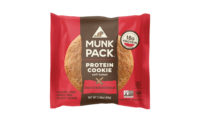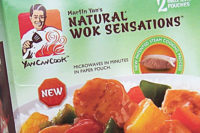Retail State of the Industry | Meals & Entrées
Consumers Warm to Frozen Entrée, Meals in New Forms, Flavors
The Frozen Chosen: Sales of frozen entrees grew at more than two and a half times the pace of overall packaged food sales through the midway point of 2018.

New line appeals with distinctive packaging, flavor profiles and trend-forward ingredients.
Photo Courtesy Of: Nestlé (www.wildscapefood.com)

New ethnic offerings boost appeal with antiobiotic-free meats and high protein.
PHOTO COURTESY OF: AMERICAN HALAL COMPANY INC. (WWW.SAFFRONROAD.COM)

New offerings tap interest in functional ingredients, breakfast daypart.
PHOTO COURTESY OF: CONAGRA BRANDS (WWW.EVOLFOODS.COM)



“If you build it, he will come” from the movie “Field of Dreams” alludes to the fact that dreams can come true if you believe and act accordingly. Meal and entrée makers have proven that this movie line rings true.
Instead of giving up on once moribund sectors like frozen meals and entrees, industry innovators have built their own “Field of Dreams” in the form of better, cleaner products. And for the first time in nearly a generation, consumers have responded. According to Acosta, 26% of all American grocery shoppers now say they are shopping the frozen food aisle more often. 43% of millennials say they are buying more frozen food items.
Sales are rising instead of falling. According to The Wall Street Journal, sales of frozen entrees grew at more than two and a half times the pace of overall packaged food sales through the midway point of 2018 after showing little to no growth the prior two years. Some sectors are now stars. Dollar sales of frozen breakfast meals grew 8.3% in 2018, per Nielsen.
Negative perceptions of packaged meals and entrées are melting away thanks to new game-changing innovations. Nestlé’s new Wildscape line of chef-inspired frozen meals—that ditch opaque boxes and trays for translucent plastic tubs for “goodness you can see”—shows that meal and entrée makers can “be the change.”
In the case of Wildscape, change means on-trend, whole food ingredients like sweet potato, cauliflower, freekeh, quinoa, chickpeas, and farro. Meal flavors like Gochujang Cauliflower and Bourbon Braised Pork are more cutting-edge than copycat.
Global flavor innovation, full ingredient transparency, sustainability, and authenticity show the road ahead. Products like Saffron Road frozen entrées show how that road takes shape with ingredients like chicken raised without antibiotics and plant-based proteins such as chickpeas and cashews. The “chef crafted” line offers a quartet of new meals including Coconut Curry Chicken with Basmati Rice.
But it is not just new or newish brands leading the charge. Standard bearers like Nestlé’s Lean Cuisine brand are transforming to tap interest in plant-based foods. Nestlé added a meatless 14-item Lean Cuisine Origins sub-line in 2018.
Created to put a “flavorful twist on plant-based proteins and vegetables,” Lean Cuisine Origins plays the “healthy swaps” game by using cauliflower and butternut squash to replace ingredients like potatoes and cheese. Two of the line’s 14 flavors—including Coconut Chickpea Curry and a Sicilian-Style Pesto with Lentil Pasta—are formulated to tap vegan consumers.
Relatively few Americans call themselves “vegans,” but their ranks are rising. Per a 2018 Gallup poll, 3% of Americans say they are vegans, up from 2% in 2012. The same poll found 5% of Americans saying they are vegetarians. While that percentage was unchanged from 2012, there is a growing sales trend toward plant-based foods.
With plant-based food sales up by 20% in 2018 (according to Nielsen), meal and entrée makers are opening the door to alternatives to animal-based proteins. Jackfruit—a tropical fruit native to India with a neutral flavor and a texture similar to pulled pork—has emerged as one of the more unusual meat substitutes.
The Jackfruit Company offers products like Smoked Pulled Jackfruit, a refrigerated plant-based alternative to pulled pork which is great on its own or served with barbecue sauce as a meal. The product is aimed at the fresh meat case. In early 2019, the company added Complete Jackfruit Meals, a line of vegan, shelf-stable, single-serving meals in flavors like Black Beans, Corn and Tex Mex Spices. Each has 260 calories or less with 6-9 grams of plant-based protein and 9g to 11g of dietary fiber.
Loma Linda Plant-Based Protein Meal Solutions also goes the shelf-stable, plant-based route. This 10-variety line offers Plant-Based Protein Meal Solutions in flavors like Spicy Pad Thai and Plant-Based Meal Starters like Taco Filling and Sloppy Joe. All products are shelf-stable and priced below most chilled or frozen meals.
Sensing an opportunity, vegetable brands are invading the center-of-the-plate. One example is Green Giant which added Southwest Style and Asian Style Harvest Protein Bowls in 2018, each with 12g to 14g of protein.
Let’s Go Bowling
Bowl meals have been huge news in meals and entrees in the past year and a half. The proliferation of bowls over this time period has touched almost every market sector.
Plant-based offerings were especially prominent in the bowl space. Lightlife Frozen Meatless Bowls are inspired by international flavors and include Chickpea Curry and Sweet Potato Shepherd’s Pie. Lundberg’s Organic Grainspirations Rice & Quinoa Bowl line has a full serving of whole grains and “responsibly sourced proteins” in each frozen bowl in flavors like Korean Style Chili.
Green Giant Fresh extends the bowl trend out of the freezer case into chilled produce with a six item line of meal bowls. Crumbled sweet potatoes are a base ingredient for the Rancheros Bowl, while crumbled cauliflower powers the Burrito Bowl.
Seafood bowls include “sustainable and traceable” LoveTheWild microwaveable seafood bowls in flavors like Hawaiian Style Tropical Bowl with Barramundi. Gorton’s offers indulgent Shrimp Bowls in flavors like Chili Lime Rice and Beans. Scott & Jon’s (formerly Cheating Gourmet) offers sustainably-sourced shrimp in its new pasta and noodle bowls like Shrimp Alfredo and Spicy Ramen.
Looking at big brands, Stouffer’s FitKitchen Bowls were on-trend in flavors like Chicken with Cashews while Banquet Mega Bowls showed that more is better with flavors like Dynamite Penne and Meatballs. Conagra used the bowl format to take its Evol brand (acquired by Conagra as part of its 2018 acquisition of Pinnacle Foods) in a new direction.
Evol Modern Nutrition Bowls are a “first of a kind” in the frozen aisle with “customized benefits.” Warrior Bowl (Be Powerful), Vitalize Bowl (Be Energized), Boost Bowl (Be Well), and Balance Bowl (Be Centered) directly connect nutrition with functionality. Sebastian Nava, Research Chef with Evol Foods, says the bowls “offer a variety of vitamins, proteins, and whole grains to provide tailored benefits.”
The Evol brand also pushed the bowl concept into the breakfast space with four new Morning Bowls, each with 11g to 17g of protein per serving. Spicy Chipotle Chorizo Bowl and Smoked Uncured Ham Benedict Bowl are highlights.
Meal and entrée makers are bullish on bowls for a host of reasons, not the least of which is that more of us are living alone these days, fueling a need for single-serving products. According to the U.S. Census Bureau, there were 35.7 million single-person households in the U.S. in 2018, representing 28% of all households and up dramatically from 13% of households in 1960.
The aging of the population is expected to fuel future expansion of single-person households. The Joint Center for Housing Studies of Harvard University projects that America will add 4.6 million single-person households by the year 2028, more than double the number of married with children households expected to be added by then.
The same demographic trends that favor bowls also benefit other single-serving meal and entrée products. That includes wrap sandwiches like Amy’s Moroccan Tagine Wrap, burritos like the Daiya Deliciously Dairy Free Santiago Burrito, pocket sandwiches like Mikey’s Breakfast Pockets, portable meal solutions like Lunchables Brunchables Breakfast Sandwiches, and comfort foods like the Devour Buffalo Chicken Grilled Cheese Sandwich.
Speaking of comfort foods, meal and entrée makers are tapping favorite comfort foods and giving them a new spin. For Conagra’s Banquet brand, that means putting macaroni and cheese in a pot pie with Banquet Mega Deep Dish Bacon Mac N Cheese.
Taking pot pie and turning it into a hand-held sandwich was a “thing” in 2018. Conagra’s Wicked Kitchen brand showed how with its Hand Pie line. So did Alpha Foods Handheld Pot Pie filled with “meat-free protein and savory sauces” in flavors like Spinach Feta.
Often overlooked, canned meals have raised their game. Vietti Artisan Craft Chili in a Chili with Beans & Porter Ale flavor channels craft beer for flavor innovation. Chef Boyardee Throwback Recipe canned meals like Lasagna and Beef Ravioli boast more meat and cheese, and retail for about 50% more than the base line.
Meal and entrée makers are cognizant that subscription meal kit companies represent an ongoing threat. And while that has not yet materialized (bellwether Blue Apron lost its CEO and CTO in April 2019), the risk remains.
Packaged meal and entrée producers are mitigating that risk with products that go after the Blue Aprons of the world. Smithfield Scratch Meal Kits provide “flavorful ingredients and simple prep” in flavors like Mongolian Style Beef. This effort is in addition to Smithfield’s partnership with Chef’d.
Stouffer’s Complete Family Meal Kit has pre-measured and pre-chopped ingredients for a family meal in less than 25 minutes. Roasted Tuscan Style Chicken and Braised Pork are two flavor options. Tyson Tastemakers Meal Kits have pre-chopped vegetables, curated spices and sauces, seasoned meat and grain or pasta. These kits go from fridge to table in 30-45 minutes in flavors like Nashville Hot & Crispy Chicken.
Fresh meal kits sold through supermarkets continue to evolve and one to watch is WW Fresh Quick-Prep Meals which debuted at over 200 Hy-Vee grocery stores in January 2019. Developed in collaboration with FreshRealm, these pre-cooked meals serve two and are priced from $14-$20. Two-Cheese Butternut Squash Rotini with Bread Crumbs is one of a half-dozen flavors.
The meal kit concept is proving to be surprisingly elastic. Ore Ida showed that with its Just Crack and Egg Ultimate Scramble Kit, a breakfast kit with pork sausage, cheese, potatoes, onions and more that requires the addition of an egg. Fresh Express Sauté Kits bring meal kits to packaged salads. Prep time is just three minutes and flavors are greens-forward, like Tuscan Kale and Lemon Garlic Spinach.
Looking for a reprint of this article?
From high-res PDFs to custom plaques, order your copy today!








